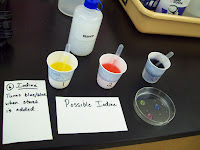In lab, we were given six stations to complete, each with three solutions potentially containing a poison. We had to test each solution with a chemical that would cause a specific reaction, indicating the presence of a poison. Each poison was identified by unique characteristics that could be found in the solution after the addition of a chemical or color- indicator.
 |
| Results Sheet with Lab Data |
Station 1: Asprin
Must have: pH below 7 and BTB must turn yellow
Solution 1: pH of 2 and BTB turned yellow (indicating an acid)
Solution 2: pH of 8 and BTB turned blue (indicating a base)
Solution 3: pH of 6 and BTB turned green (indicating neutral solution)
Station 2: Cyanide
 |
| Petri Dish with Cyanide tested solutions (P.S. I have no idea who wrote on the notecard) |
Turns blood red when Fe (+3) is added
Solution 1: No color change
Solution 2: Blood red
Solution 3: No color change
Station 3: Iodine
Solution 1: No color change (stayed yellow)
Solution 2: No color change (stayed red)
Solution 3: Blue/Black (from colorless)
 |
| Solutions after testing |
Indications are:
1) +Cr = orange when acidified
2) +Pb = yellow precipitate when KI is added
3) +Fe = blood red when KSCN is added
Solution 1: Contains no Cr but does contain Pb
Solution 2: Contains no Cr but does contain Fe
Solution 3: Contains no Cr, Fe, or Pb
When Benedict Solution is added, a purple color will form
Solutions 1,2, and 3 contain no sugar (all remained colorless)
Indicators include:
1) Odor
2) pH above 7
3) pHth is pink purle in solution (indicating basic solution)
Solution 1: pH of 11 and pHth turns pink
Solution 2: pH of 8 and pHth has no effect
Solution 3: pH of 8 and pHth has no effect
 |
| Solution After Testing |
Definition of Poison: A substance that, when introduced into or absorbed by a living organism, causes death or injury, esp. one that kills by rapid action.
Common Poison Sources:
- Carbon monoxide is a deadly gas which is odorless.
- Household products are poisonous if eaten or drunk.
There are many products lining the shelves of the
supermarket that are designed to improve health,
- hygiene and a sense of comfort. They can be harmful
if not used properly.
- Bites from insects or spiders can be poisonous.
- Medicines used incorrectly can be dangerous.
How do Crime Labs handle poison cases? What are some signs of poisoning?
Evidences of poisoning could be bruises (injection site), changes in skin color, dilated pupils, foaming at mouth, internal bleeding, increased heart rate, and rapid breathing. Crime labs search for these evidences using various chemical tests. Toxicology staff members analyze biological samples for the presence of drugs, poisons and other toxins. Scientists often assist coroners in determining the cause of death. They also check for evidence of drug abuse by people on parole or probation.
Symptoms of Poisoning
 Some poisons enlarge the pupils, while others shrink them.
Some poisons enlarge the pupils, while others shrink them.  Some result in excessive drooling, while others dry the mouth and skin.
Some result in excessive drooling, while others dry the mouth and skin.  Some speed the heart, while others slow the heart.
Some speed the heart, while others slow the heart.  Some increase the breathing rate, while others slow it.
Some increase the breathing rate, while others slow it.  Some cause pain, while others are painless.
Some cause pain, while others are painless.  Some cause hyperactivity, while others cause drowsiness. Confusion is often seen with these symptoms.
Some cause hyperactivity, while others cause drowsiness. Confusion is often seen with these symptoms.







Its great how this post is organized and the pictures provide great insight on the lab. Good Post
ReplyDeleteGreat info and I like the poison lab a lot. I t sounds fun but you didn't test real drugs did you? I don't think that would go well in a school.
ReplyDeleteNo we didn't use real drugs. Everything we tested was harmless because it was synthetic
ReplyDelete